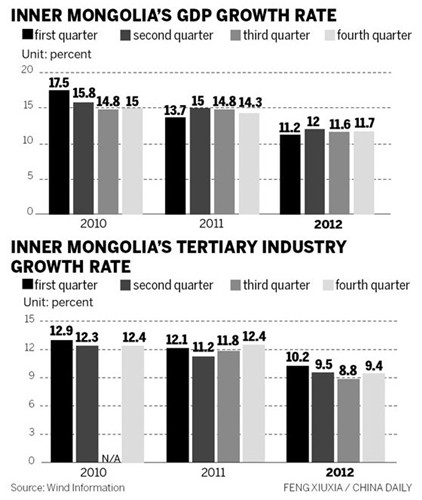![A China Telecom cloud-computing center under construction in January in a suburb of Hohhot, the Inner Mongolia autonomous region.[Photo/China Daily] A China Telecom cloud-computing center under construction in January in a suburb of Hohhot, the Inner Mongolia autonomous region.[Photo/China Daily]](U468P886T1D49324F12DT20130207150817.jpg)
A China Telecom cloud-computing center under construction in January in a suburb of Hohhot, the Inner Mongolia autonomous region.[Photo/China Daily]

The Inner Mongolia autonomous region, China's biggest coal producer, is aiming to transform its growth model through the construction of the country's largest cloud-computing industry base
Endless grassland and beautiful clouds are the iconic scenes of the Inner Mongolia autonomous region in northern China. Now a new kind of "cloud" is attracting more attention.
Hohhot, the regional capital, is emerging as the country's most important cloud-computing center.
After driving eastward half an hour from downtown Hohhot, wide new plots of land ready for large construction projects can be seen.
With the temperature lower than -10 C in the middle of winter, snow lies thick on the ground.
Construction workers had left the building site and returned home two weeks before the Spring Festival, leaving a large unfinished five-story building.
From outside, looking at the French windows, the building looks similar to other grandiose assembly halls in China.
"Here may be the heart of China's largest e-commerce company Alibaba in the future," said Hao Lianzeng, head of the Hongsheng Industrial Park, pointing to the new building.
The "heart" which Hao referred to is the cloud-computing center formed by server clusters being constructed by China Unicom, one of the three major telecom operators in China.
Upon its completion, the center will be able to provide data storage, processing and transmission services for hundreds of Internet businesses, said Hao.
"IT companies will be able to rent the servers from telecom operators, which is the basic business model," he said.
A cloud-computing platform is a flexible system that enables companies to design, launch and manage customized applications supported by a global or regional network of data centers.
Applications on the public cloud can be integrated and users are able to share information.
The fast computing and large storage capacity can help upgrade IT companies' research and development capabilities and cut operating costs, according to analysts.
Hohhot's project was launched in May 2012, when China Unicom announced plans to build a massive information industry base in the city with a cloud-computing center, an Internet data center and an enterprise data center.
A report from the company said that it planned to invest around 12.3 billion yuan ($1.9 billion) over the next 10 years in the construction of the cloud-computing project.
The project, in the Hongsheng Industrial Park, covers an area of 65 hectares, with a construction area of 598,000 square meters.
China Unicom Vice-President Zhang Junan said that the center will be one of the most advanced and environmentally friendly information and communication bases in the country.
One reason for the company to choose Hohhot as the center's location is that its Inner Mongolia subsidiary owns an 859-gigabyte international border communication network, making it China's largest exporter of telecommunication transmissions crossing the land border and giving it a vital advantage in connecting with the rest of the world.
The infrastructure construction and operation of the cloud-computing system require a great deal of electricity. Compared with other parts of China, Inner Mongolia, the nation's largest coal producer, can offer a relatively lower electricity price.
In addition, the relatively cheaper land, stable geological conditions and cool weather have also helped this region win favor from the telecom giant.
China Telecom Corp and China Mobile Ltd, the nation's two other biggest telecom operators, have also released cloud-computing blueprints for Hohhot, with planned investments of 12 billion yuan each.

Copyright ©1999-2011 Chinanews.com. All rights reserved.
Reproduction in whole or in part without permission is prohibited.